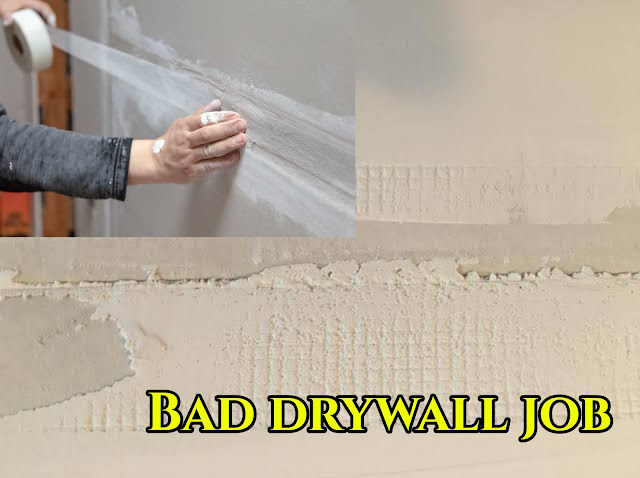Consequences of a Bad Drywall Job with signs and recognize with fixing during installation of bad drywall job
Introduction
Finishing and Installation of Bad Drywall job is a crucial part of any home or building construction project. It is what gives walls and ceilings a smooth and even appearance, providing a clean canvas for painting and decoration. However, the results of a subpar drywall work can be annoying and even expensive. How do you know if joint compound is bad? The consequences of a poor drywall work can be severe and range from obvious cracks and uneven surfaces to peeling paint and structural damage. In this piece, we’ll look at a few of the problems that frequently result from subpar drywall installation and offer advice on how to prevent them.

Causes
Poor workmanship to environmental variables are just a few of the causes of a bad drywall job and how to fix a bad drywall joint. Among the most frequent reasons are:
Use of subpar materials: Using subpar plasterboard or drywall compound can result in issues like paint that is peeling, crumbling, and cracking.
Understanding these causes will help you avoid them and take the necessary precautions to ensure a successful drywall work.
Signs of bad drywall job
There are several indicators of poor sheetrock work. Among the most typical indications are:
Visible cracks: A poor drywall work will frequently show signs of cracks in the drywall. These can happen as a result of poor installation, inadequate drying time, or shifts in the humidity and temperature.
Mold or mildew: Drywall that has been installed or finished improperly may collect moisture, which can result in the development of mold or mildew.
Uneven surfaces: Surface irregularities like lumps or depressions may be a sign of shoddy drywall finishing or installation.
Peeling paint: If the paint on the drywall is flaking or peeling off, it might not have been finished or prepared correctly before painting.
Gaps or seams: Visible gaps or seams between drywall sections can be an indication of sloppy construction or a disregard for detail.
Sagging or bulging: Drywall that is sagging or bulging could indicate poor installation or inadequate support.
If any of these symptoms are present, it might be necessary to hire a specialist to inspect and fix the drywall work. Early resolution of these problems can help to limit potential damage and guarantee a positive result.
Remedies to avoid bad drywall job
To avoid a bad drywall job, here are some remedies to consider:
Hire a professional: Making ensuring the drywall job is done correctly can be achieved by hiring a qualified and reputable contractor.
Pick high-quality materials: To produce a long-lasting and durable outcome, use high-quality drywall and drywall compound.
Appropriate installation: Ensure that the drywall is properly installed, including the right cutting, spacing, and fastening.
Allow enough time for drying: Drywall compound requires time to cure and dry completely before painting or finishing. Observe the drying time guidelines provided by the manufacturer.
Pay attention to temperature and humidity: Drywall can be impacted by changes in humidity and temperature, which can cause it to expand or compress. Use a dehumidifier in places with high humidity levels and stay away from installing drywall in highly hot or humid environments.
Finish the drywall properly: To obtain a uniform appearance, the surface should be smoothed and sanded. Additionally, it will help keep the paint from peeling and splitting.
You can help ensure that your drywall job is done properly and prevent the frustration and expense of a poor drywall job by using these fixes.
How to fix bad drywall job
Fixing a bad drywall job will depend on the specific issues that are present. Here are some general steps that can help with common problems:
1. For visible cracks, use joint compound to fill in the gaps. Allow the compound to dry completely, then sand the surface until it is smooth.
2. For uneven surfaces, sand down the high spots and fill in any low spots with joint compound. Allow the compound to dry completely, then sand the surface until it is smooth.
3. For peeling paint, scrape off the loose paint and sand the surface until it is smooth. Apply a primer to the surface before repainting.
4. For gaps or seams, apply joint compound to fill in the gaps. Allow the compound to dry completely, then sand the surface until it is smooth.
5. For sagging or bulging drywall, additional support may be needed. This can be achieved by installing additional drywall screws or using support brackets.
6. For mold or mildew, the affected area should be thoroughly cleaned and dried. If the drywall is severely damaged, it may need to be replaced.
If you are not confident in your ability to fix a bad drywall job, it may be best to hire a professional. They will be able to assess the extent of the damage and recommend the best course of action. By fixing a bad drywall job early, you can prevent further damage and ensure a successful outcome.

Leave a Reply